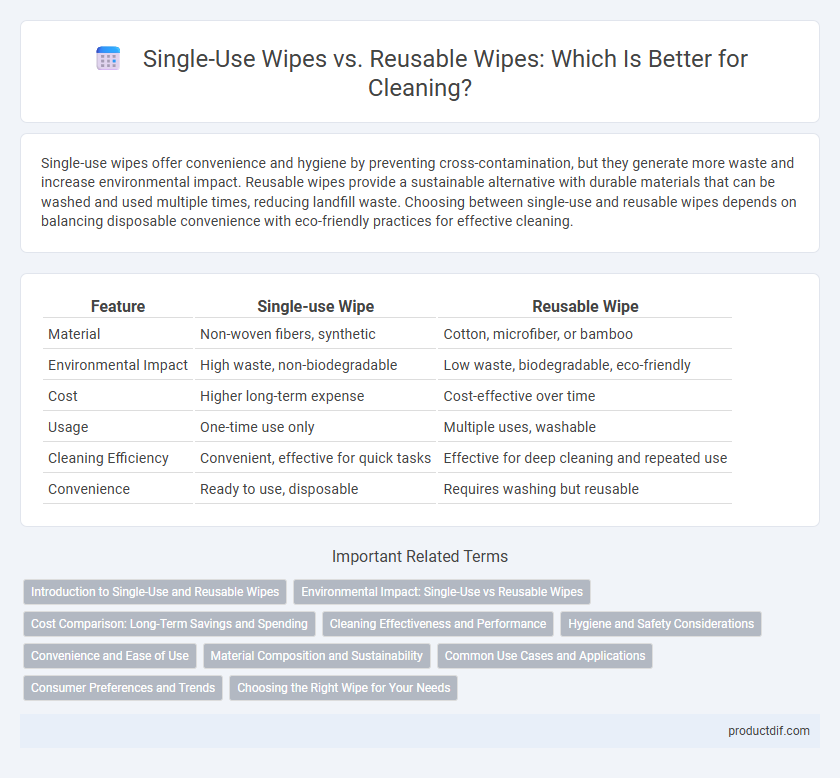Single-use wipes offer convenience and hygiene by preventing cross-contamination, but they generate more waste and increase environmental impact. Reusable wipes provide a sustainable alternative with durable materials that can be washed and used multiple times, reducing landfill waste. Choosing between single-use and reusable wipes depends on balancing disposable convenience with eco-friendly practices for effective cleaning.
Table of Comparison
| Feature | Single-use Wipe | Reusable Wipe |
|---|---|---|
| Material | Non-woven fibers, synthetic | Cotton, microfiber, or bamboo |
| Environmental Impact | High waste, non-biodegradable | Low waste, biodegradable, eco-friendly |
| Cost | Higher long-term expense | Cost-effective over time |
| Usage | One-time use only | Multiple uses, washable |
| Cleaning Efficiency | Convenient, effective for quick tasks | Effective for deep cleaning and repeated use |
| Convenience | Ready to use, disposable | Requires washing but reusable |
Introduction to Single-Use and Reusable Wipes
Single-use wipes offer convenience and hygiene by providing a fresh, sterile surface for each cleaning task, reducing the risk of cross-contamination. Reusable wipes, typically made from durable materials like microfiber, provide cost-effectiveness and environmental benefits by allowing multiple uses after washing. Understanding the balance between convenience, sanitation, and sustainability is essential when choosing between single-use and reusable wipes for cleaning purposes.
Environmental Impact: Single-Use vs Reusable Wipes
Single-use wipes generate significant landfill waste and contribute to microplastic pollution, posing long-term environmental hazards. Reusable wipes reduce waste output by being washable and durable, decreasing overall resource consumption over time. Choosing reusable options supports sustainable practices by minimizing plastic waste and lowering carbon footprints in cleaning routines.
Cost Comparison: Long-Term Savings and Spending
Single-use wipes may have a lower upfront cost but lead to higher long-term expenses due to frequent repurchasing and environmental disposal fees. Reusable wipes involve a higher initial investment but significantly reduce ongoing spending through multiple uses and lower waste management costs. Over time, reusable wipes offer greater cost efficiency and sustainable savings for households and businesses.
Cleaning Effectiveness and Performance
Single-use wipes offer consistent cleaning effectiveness by delivering pre-measured cleaning agents that eliminate bacteria and dirt quickly, ensuring hygienic results in every application. Reusable wipes may require additional cleaning products to maintain performance but provide superior abrasive action for stubborn stains, enhancing deep cleaning capabilities over repeated use. Choosing between single-use and reusable wipes depends on balancing immediate sanitation needs with long-term cleaning performance and environmental impact.
Hygiene and Safety Considerations
Single-use wipes provide superior hygiene by eliminating cross-contamination risks, as they are disposed of immediately after use. Reusable wipes require thorough cleaning and regular disinfection to prevent bacterial buildup and ensure safety. Choosing single-use wipes enhances infection control measures in sensitive environments, including healthcare and food service.
Convenience and Ease of Use
Single-use wipes offer unmatched convenience with their ready-to-use format, eliminating the need for laundering and reducing cross-contamination risks. Reusable wipes require washing after each use, which may add effort but provide long-term cost savings and environmental benefits. Both options cater to different user preferences, balancing immediate ease with sustainability considerations.
Material Composition and Sustainability
Single-use wipes are typically made from non-woven polypropylene or polyester fibers, often infused with cleaning agents, but their synthetic composition contributes to environmental waste and slow biodegradation. Reusable wipes are commonly made from natural fibers like cotton or bamboo, which offer enhanced sustainability through biodegradability and the ability to withstand multiple wash cycles. Choosing reusable wipes reduces landfill contribution and lowers overall carbon footprint associated with disposable wipe production and disposal.
Common Use Cases and Applications
Single-use wipes are ideal for disinfecting high-traffic areas such as kitchen counters, doorknobs, and bathroom surfaces where quick, hygienic disposal prevents cross-contamination. Reusable wipes excel in applications like cleaning delicate electronics, glass surfaces, or upholstery, where gentle care and environmental sustainability are priorities. Both types serve essential roles in maintaining cleanliness, with single-use wipes favored for convenience and hygiene, while reusable wipes reduce waste and cost in routine cleaning tasks.
Consumer Preferences and Trends
Consumer preferences shift towards reusable wipes due to growing environmental awareness and cost-effectiveness, with 65% of users prioritizing sustainability in their cleaning choices. Market trends show a 30% annual increase in demand for eco-friendly reusable wipes compared to single-use options, driven by concerns over plastic waste and chemical exposure. Despite this, single-use wipes remain popular for convenience, especially in healthcare and childcare sectors, where hygiene and quick disposal are critical factors.
Choosing the Right Wipe for Your Needs
Single-use wipes offer convenience and hygiene by eliminating cross-contamination risks, making them ideal for quick cleanups and sensitive environments. Reusable wipes provide cost-effectiveness and environmental benefits, as they can be washed and used multiple times without losing effectiveness. Assess your cleaning frequency, surface type, and sustainability goals to determine whether disposable or reusable wipes best suit your specific needs.
Single-use wipe vs reusable wipe Infographic

 productdif.com
productdif.com